The Acer Aspire S7-393 Review: Broadwell Comes To Acer's Ultrabook
by Brett Howse on October 5, 2015 8:00 AM ESTDisplay
Acer does offer the Aspire S7 with a 2560x1440 display, but the model shipped to me has the base 1920x1080 IPS panel. This touch panel has a full RGB stripe and being IPS offers great off-angle viewing. The move to 2560x1440 would give slightly crisper text but at the cost of battery life, so it is a choice to not be taken lightly.
The panel itself is an AUO model and right away one of the first things I noticed was that there is quite a bit more backlight bleed than there should be on a notebook at this price range. There is visible leakage on the sides which is not too distracting, but also some uneven blacks. It’s not a huge issue though and is really only noticeable when the display is completely black but the backlight is on a bright setting.
To measure the display characteristics, we use SpectraCal’s CalMAN 5 suite with a custom workflow. Contrast and brightness levels are measures with an X-Rite i1DisplayPro colorimeter, and color accuracy is checked with an X-Rite i1Pro spectrophotometer.
Brightness and Contrast

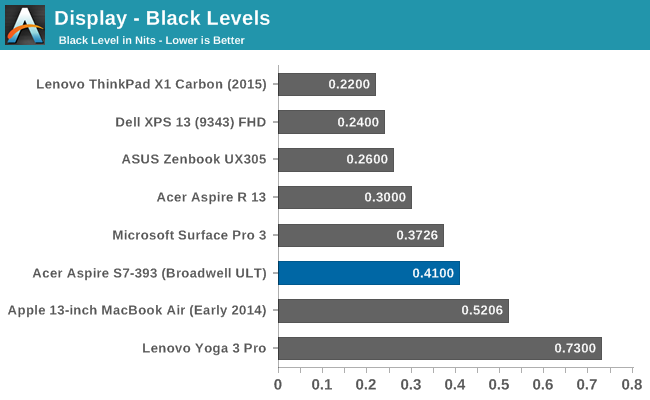
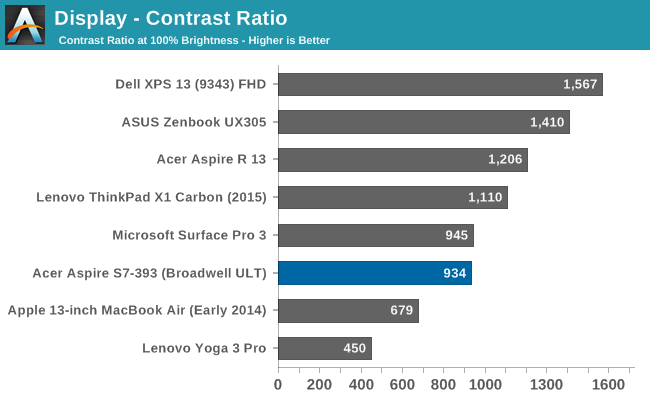
The Acer S7 gets to 391 nits at 100% brightness which is generally plenty bright for more notebook tasks. Decent black levels lead to a static contrast of 934:1. It is not quite as good as the Sharp IGZO panels but a reasonable result.
Grayscale


As you can see in the results, the grayscale is overall 4.16 which is not a terrible result, but the greens really creep up as the display gets closer to 100% white causing noticeable errors as the white value goes up. Color temperature is higher than it should be at 7077 and gamma is also a bit high.
Saturation
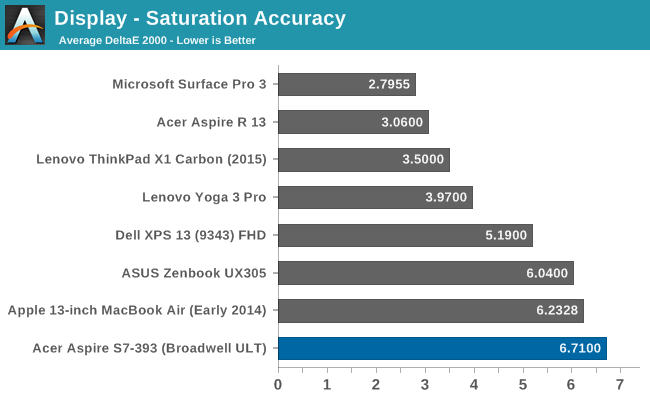
Saturation is where the Acer’s display falls on its face. An overall value of 6.72 is not the worst we have ever seen (by a long shot) but on a $1400 Ultrabook there are some major issues when the display can’t cover the sRGB color space. 100% blue is registering as only 60% blue, which combined with the compressed reds cause the magenta to also be very compressed. The Acer S7 only actually covers 72% of the sRGB gamut which is a very poor performance.
GMB
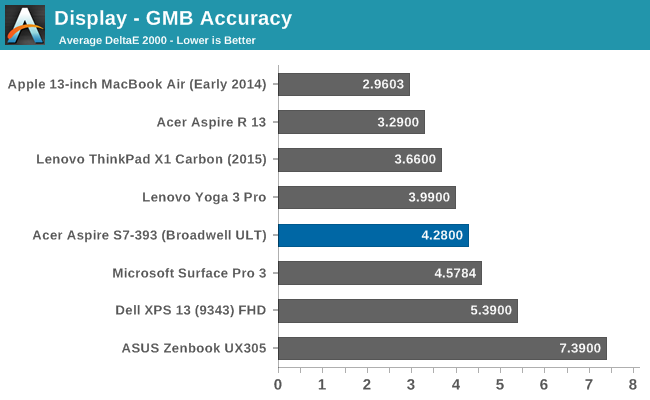
The Gretag Macbeth colorchecker is a more comprehensive test. It comes in at not a terrible result at 4.29 but you can visibly see how much of the blue and magenta gamut is just missing from the result. Good scores on the green, yellow, and decent grayscale help pull this score back to a reasonable result, but in the end we are looking for a dE of less than three, which the S7 does not meet in any of these tests.
Color Comparator
Since discussing color inaccuracies can be difficult to comprehend with just numbers, the above images are a relative comparison of what color is called for (on the bottom) and the color that is reproduced by this display (on the top) with a focus on this being a relative comparison. Any inaccuracies in your own monitor will shift the results for both values. You can really see how the blue values are just not anywhere near as blue as they should be.
Calibrated
Since this is a Windows PC, we can calibrate the display to try and get a better result, however without a 3D Look Up Table the only thing that can really be fixed is gamma and grayscale.
Once calibrated, the grayscale comes out much better, which helps pull the GMB score down further since whites and blacks are part of that test. The saturation sweep shows no difference though.
When a company sells a device for this price, you have to expect and demand better than the display in this notebook. It is really unacceptable to have a display which covers just 72% of sRGB at this price point. The competition has come out with some pretty fantastic displays over the last year or two, so Acer needs to step up their game. It is no longer good enough to just include an IPS panel, at least not at this price. When a $500 Microsoft Surface 3 can come with a fantastically accurate display out of the box, others can do it too.


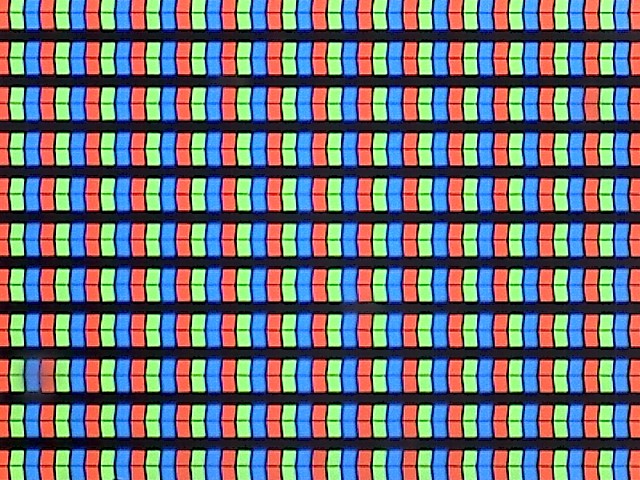
















63 Comments
View All Comments
smorebuds - Monday, October 5, 2015 - link
the hyperbole is strong with this onecgalyon - Monday, October 5, 2015 - link
While "perfect" is probably an understatement, it was quite good, except the keyboard. I make no exaggeration when I say that it was not possible to type much more than a short word without having to make a correction. People were modifying registry files in an attempt to compensate (by changing the latency between detected key presses)DanNeely - Monday, October 5, 2015 - link
I'm a bit surprised that Acer would want you to review a Broadwell model now when Skylake is out. Was this laptop stuck in your todo queue for a while?lmcd - Monday, October 5, 2015 - link
Most of Skylake is a connectivity upgrade, no? Which would be lost on a unit like this, with nearly no connectivity to speak of.DanNeely - Monday, October 5, 2015 - link
That's true for desktop processors. On the mobile side, improvements to power management and a bigger IGP have potential to make significant improvements to some performance numbers.lilmoe - Monday, October 5, 2015 - link
Acer probably got a better deal for those parts...p1esk - Monday, October 5, 2015 - link
Those specs at that price would be OK back in 2012. But now? At $799 it could sell a few. At $999? Meh, no thanks. At the asking price? You gotta be completely crazy.kmmatney - Monday, October 5, 2015 - link
I'm pretty sure Intel is charging up the nose for the Intel Core i7-5500U - easily adds a few hundred to the price over an i5.solipsism - Monday, October 5, 2015 - link
May I request when detailing the USB ports going forward to make clear if it's USB-A or USB-C.lilmoe - Monday, October 5, 2015 - link
"Something pretty remarkable is that Acer has sampled us nearly identical Aspire S7 models for the past three generations"I would have gotten excited here since I wanted a good comparison between Haswell and Broadwell in terms of efficiency. But I'm not sure if even this is a good comparison since you're not using the same browser for battery life tests. Edge is the most efficient browser on Windows.
It would have been nice if you also posted battery tests using IE for this particular product since you have identical specs other than the CPU.
On to the product itself, dat screen is seriously awful... The price tag is a bit high. Otherwise, not too shabby.